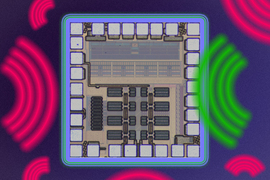Imagine sitting in a packed stadium for a pivotal football game — tens of thousands of people are using mobile phones at the same time, perhaps video chatting with friends or posting photos on social media. The radio frequency signals being sent and received by all these devices could cause interference, which slows device performance and drains batteries.
Designing devices that can efficiently block unwanted signals is no easy task, especially as 5G networks become more universal and future generations of wireless communication systems are developed. Conventional techniques utilize many filters to block a range of signals, but filters are bulky, expensive, and drive up production costs.
MIT researchers have developed a circuit architecture that targets and blocks unwanted signals at a receiver’s input without hurting its performance. They borrowed a technique from digital signal processing and used a few tricks that enable it to work effectively in a radio frequency system across a wide frequency range.
Their receiver blocked even high-power unwanted signals without introducing more noise, or inaccuracies, into the signal processing operations. The chip, which performed about 40 times better than other wideband receivers at blocking a special type of interference, does not require any additional hardware or circuitry. This would make the chip easier to manufacture at scale.
“We are interested in developing electronic circuits and systems that meet the demands of 5G and future generations of wireless communication systems. In designing our circuits, we look for inspirations from other domains, such as digital signal processing and applied electromagnetics. We believe in circuit elegance and simplicity and try to come up with multifunctional hardware that doesn’t require additional power and chip area,” says senior author Negar Reiskarimian, the X-Window Consortium Career Development Assistant Professor in the Department of Electrical Engineering and Computer Science (EECS) and a core faculty member of the Microsystems Technology Laboratories.
Reiskarimian wrote the paper with EECS graduate students Soroush Araei, who is the lead author, and Shahabeddin Mohin. The work is being presented at the International Solid-States Circuits Conference.
Harmonic interference
The researchers developed the receiver chip using what is known as a mixer-first architecture. This means that when a radio frequency signal is received by the device, it is immediately converted to a lower-frequency signal before being passed on to the analog-to-digital converter to extract the digital bits that it is carrying. This approach enables the radio to cover a wide frequency range while filtering out interference located close to the operation frequency.
While effective, mixer-first receivers are susceptible to a particular kind of interference known as harmonic interference. Harmonic interference comes from signals that have frequencies which are multiples of a device’s operating frequency. For instance, if a device operates at 1 gigahertz, then signals at 2 gigahertz, 3 gigahertz, 5 gigahertz, etc., will cause harmonic interference. These harmonics can be indistinguishable from the original signal during the frequency conversion process.
“A lot of other wideband receivers don’t do anything about the harmonics until it is time to see what the bits mean. They do it later in the chain, but this doesn’t work well if you have high-power signals at the harmonic frequencies. Instead, we want to remove harmonics as soon as possible to avoid losing information,” Araei says.
To do this, the researchers were inspired by a concept from digital signal processing known as block digital filtering. They adapted this technique to the analog domain using capacitors, which hold electric charges. The capacitors are charged up at different times as the signal is received, then they are switched off so that charge can be held and used later for processing the data.
These capacitors can be connected to each other in various ways, including connecting them in parallel, which enables the capacitors to exchange the stored charges. While this technique can target harmonic interference, the process results in significant signal loss. Stacking capacitors is another possibility, but this method alone is not enough to provide harmonic resilience.
Most radio receivers already use switched-capacitor circuits to perform frequency conversion. This frequency conversion circuitry can be combined with block filtering to target harmonic interference.
A precise arrangement
The researchers found that arranging capacitors in a specific layout, by connecting some of them in series and then performing charge sharing, enabled the device to block harmonic interference without losing any information.
“People have used these techniques, charge sharing and capacitor stacking, separately before, but never together. We found that both techniques must be done simultaneously to get this benefit. Moreover, we have found out how to do this in a passive way within the mixer without using any additional hardware while maintaining signal integrity and keeping the costs down,” he says.
They tested the device by simultaneously sending a desired signal and harmonic interference. Their chip was able to block harmonic signals effectively with only a slight reduction in signal strength. It was able to handle signals that were 40 times more powerful than previous, state-of-the-art wideband receivers.










